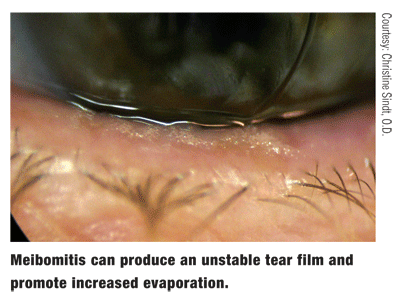 The relationship between contact lenses and dry eye is unique. One study indicated that contact lens wear may induce dry eye.1 Yet, wearing contact lenses can also be an effective treatment option for dry eye.2 This months column focuses on dry eye in contact lens wearers and the potential to reduce contact lens intolerance with new materials and designs.
The relationship between contact lenses and dry eye is unique. One study indicated that contact lens wear may induce dry eye.1 Yet, wearing contact lenses can also be an effective treatment option for dry eye.2 This months column focuses on dry eye in contact lens wearers and the potential to reduce contact lens intolerance with new materials and designs.
Increased Evaporation
Soft contact lenses tend to increase evaporation of the tears, irrespective of evaporation from the contact lens itself.3 One study, for example, measured corneal hydration levels in rabbits that were fit with contact lenses to purposefully induce microtrauma. The contact lenses caused glucose and lactate levels in both the cornea and the tears to increase, and adenosine 5-triphosphate (ATP) and glycogen levels to decrease.4
This evidence suggests that a metabolic change transpired. Such a metabolic change probably would not occur if the eye had good oxygen permeability and tear flow or was devoid of microtrauma caused by improperly fit contact lenses.
The lipid layer, which covers both the corneal surface and the contact lens itself, may be essential in preventing evaporation. With an intact lipid layer, the lacrimal gland easily compensates for the small water loss resulting from natural evaporation. However, when tear production is compromised by contact lens wear, evaporation increases significantly.5
Compromised Surface
Many studies have shown that patients with dry eye often have a compromised ocular surface. Deficiencies in tear volume result in osmolarity changes and cause decreased levels of key enzymes, such as lysozyme, lactoferrin and  beta-lysin.6 These conditions can lead to a greater risk of infection.
beta-lysin.6 These conditions can lead to a greater risk of infection.
This may be most evident in soft contact lens wearers with poor tear exchange under the lens. Michael A. Lemp, M.D., found that under such circumstances, limited tear flow generates a greater buildup of both lens deposits and metabolic waste, and promotes increased tear evaporation from the contact lens.6 The pathogenesis of infection involves various mechanisms, including decreased tear components, diminished tear flow under the lens, stagnation and alterations in surface cell exfoliation.
Individuals who suffer from dry eye should not automatically be excluded from contact lens wear because myriad factors can cause or exacerbate dry eye. These include environmental conditions, smoking, diet, lid disease, lid anatomy, blink rate, medications, systemic disease, gender and age.7 Marginal dry eye, often caused by other predisposing variables, poses no real danger to ocular health.8 Helpful remedies for contact lens wearers include rewetting drops or artificial tears; forced blinking exercises; or modification of contact lens type, wear schedule or material.
Lens Modifications
With the large selection of contact lenses and materials available, we must consider which types of lenses may be best suited for patients who suffer from dry eye or other ocular surface conditions. For example, a high Dk material, such as balafilcon A or lotrafilcon A, should reduce corneal edema, and would be the most sensible contact lens choice for a patient who requires epithelial healing.9 Studies conducted more than 20 years ago even suggested that such silicone-containing lenses may be beneficial when managing dry eye.3
Many doctors have debated whether low or high water content lenses are more appropriate for patients who suffer from dry eye. The answer simply may depend on the patients compliance and maintenance of hydration. One study found that patients who suffer from dry eye benefited from wearing high water content lenses if adequate unpreserved tear supplementation is provided, regardless of whether the patient has previously undergone punctal occlusion.10
Another study, however, suggested that high water content lenses compromise the tear film more than low water content lenses and that they should not be recommended for dry eye patients with low Schirmer scores.10 Additional research has shown that low water content lenses remain hydrated longer than high water content lenses.3
Further research has demonstrated that non-ionic, low water content lenses have shown significant improvement in several subjective categories, including wearer comfort, dryness, and frequency of eye irritation and burning. This analysis also revealed that non-ionic, low water content lenses produced considerably less on-eye dehydration and corneal staining than did other daily wear contact lenses in subjects with mild to moderate dry eye.11
Daily disposable lenses would likely benefit patients by reducing buildup of deposits. This approach may also aid patients with allergies and blepharitis.12
Contact lenses are likely one of many contributing factors to dry eye. A poor tear film can cause contact lens intolerance and produce ocular surface damage.13 Studies of eyelid disorders have demonstrated that meibomitis can produce an unstable tear film and promote increased evaporation, which would make contact lens wear difficult.14 We must perform a thorough dry eye examination on contact lens candidates, including investigation of the lids for meibomitis and other lid diseases that could increase the risk of infection.
1. Albietz J, Sanfilippo P, Troutbeck R, Lenton LM. Management of filamentary keratitis associated with aqueous-deficient dry eye. Optom Vis Sci 2003 Jun;80(6):420-30.
2. Diller R, Sant S. A case report and review of filamentary keratitis. Optometry 2005 Jan;76(1):30-6.
3. Mackie IA. Contact lenses in dry eyes. Trans Ophthalmol Soc U K 1985;104 (Pt 4):477-83.
4. Reim M,
5. Mathers W. Evaporation from the ocular surface. Exp Eye Res 2004 Mar;78(3):389-94.
6. Lemp MA. Is the dry eye contact lens wearer at risk? Yes. Cornea 1990;9 Suppl 1:S48-50; discussion S54.
7. Wolkoff P, Nojgaard JK, Troiano P, Piccoli B. Eye complaints in the office environment: precorneal tear film integrity influenced by eye blinking efficiency. Occup Environ Med 2005 Jan;62(1):4-12.
8. Finnemore VM. Is the dry eye contact lens wearer at risk? Not usually. Cornea 1990;9 Suppl 1:S51-3; discussion S54.
9. Foulks GN, Harvey T, Raj CV. Therapeutic contact lenses: The role of high high-Dk Lenses. Ophthalmol Clin North Am 2003 Sep;16(3):455-61.
10. Bhatia RP, Panday K, Srivastava R, Indolia HS. Are high-water-content contact lenses safe? Ann Ophthalmol (
11. Lemp MA, Caffery B, Lebow K, et al. Omafilcon A (Proclear) soft contact lenses in a dry eye population. CLAO J 1999 Jan;25(1):40-7.
12. Lemp MA. Contact lenses and associated anterior segment disorders: dry eye, blepharitis and allergy. Ophthalmol Clin North Am. 2003 Sep;16(3):463-9.
13. Foulks GN. What is dry eye and what does it mean to the contact lens wearer? Eye Contact Lens. 2003 Jan;29(1 Suppl):S96-100; discussion S115-8, S192-4.
14. McCulley JP, Shine WE. Eyelid Disorders: The Meibomian meibomian gland, blepharitis and contact lenses. Eye Contact Lens. 2003 Jan;29(1 Suppl):S93-5; discussion S115-8, S192-4.

